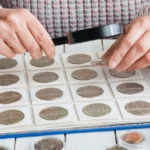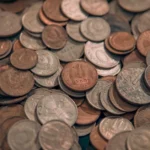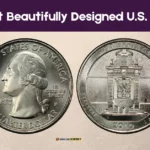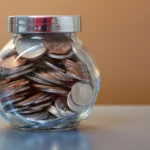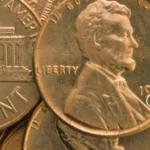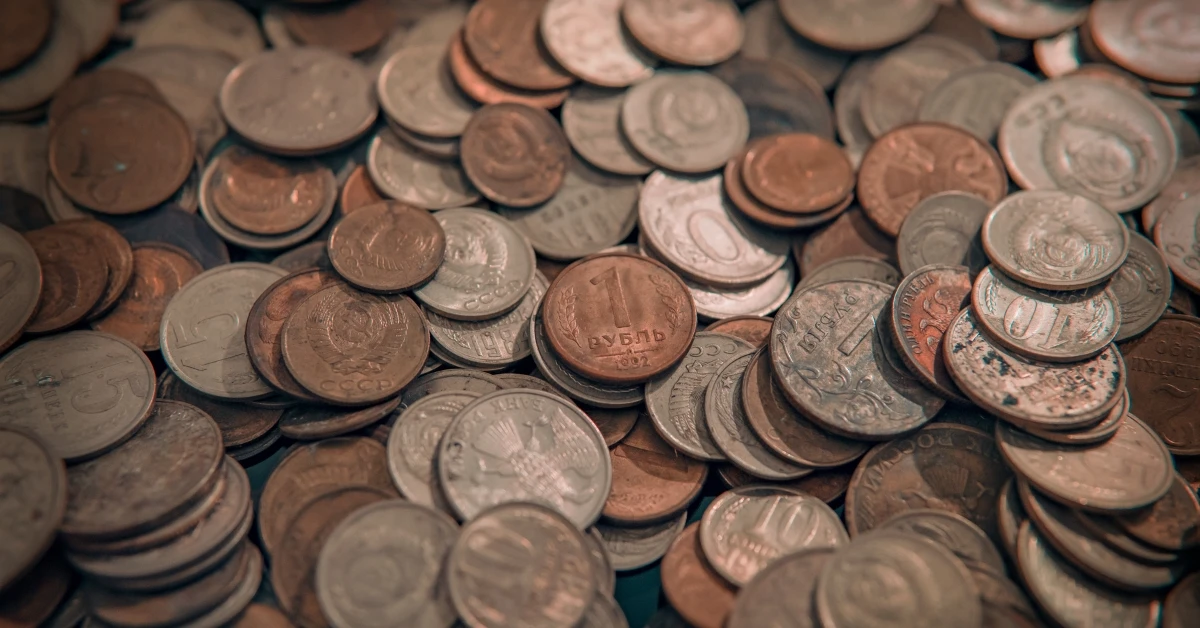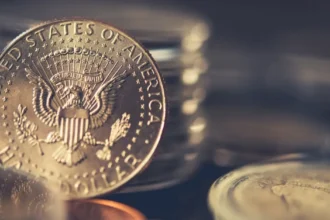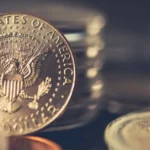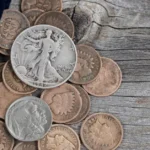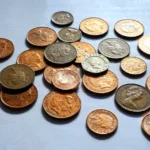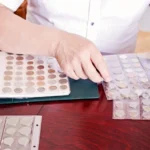A coin’s grade plays a crucial role in determining its value, and Coin damage affect its value and grade is a a key factor for collectors and investors. The grade reflects a coin’s condition, rarity, and overall appeal, directly influencing its market price and desirability.
Spotting damage early is essential for preserving and maintaining a coin’s grade. Issues like surface scratches, environmental damage, or improper storage can significantly reduce a coin’s quality, leading to a drop in its value. By identifying potential problems before they worsen, collectors can take steps to protect their investment.
Damage can occur in various scenarios, whether through mishandling, exposure to unfavorable conditions, or even during attempts to clean a coin. Understanding these risks and how they impact a coin’s grade empowers collectors to care for their coins and ensure their lasting value.
What is Coin Grading?
Coin grading is the process of evaluating a coin’s condition to determine its quality and assign it a grade. This grade serves as a standardized measure of the coin’s state of preservation, which directly impacts its value and appeal to collectors and investors.
Grading typically uses the Sheldon Scale, which ranges from Poor (P-1) to Mint State (MS-70), with higher numbers indicating better quality. Coins graded at the highest levels, like MS-70, are considered flawless, while lower grades reflect varying degrees of wear, damage, or imperfections.
Professional coin grading organizations, such as the Professional Coin Grading Service (PCGS) or the Numismatic Guaranty Company (NGC), apply strict criteria when grading coins. These include evaluating features like luster, strike quality, surface preservation, and overall eye appeal.
Coin grading helps establish trust in the marketplace, ensuring buyers and sellers have a common understanding of a coin’s condition. For collectors, a properly graded coin provides assurance of authenticity and a benchmark for assessing value. Understanding grading standards and how damage influences them is crucial for anyone in the world of numismatics.
Types of Damage That Lower a Coin’s Grade
Understanding the types of damage that affect a coin’s grade is crucial for collectors and investors. Below, we explore various forms of damage, how to identify them, and their impact on a coin’s value.
1. Surface Scratches and Hairlines
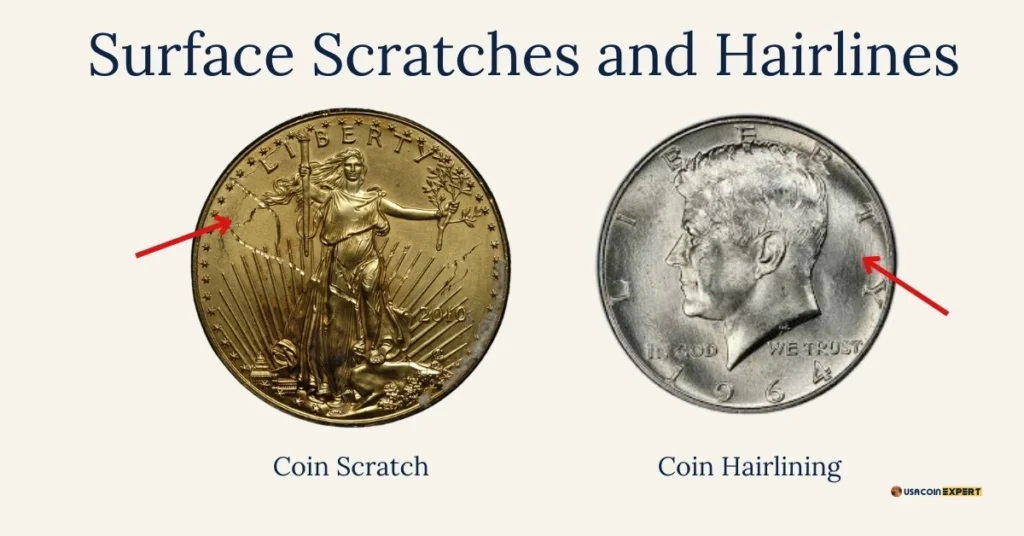
- How to Spot Them: Use direct lighting and a magnifying tool to look for fine lines or scratches on the coin’s surface. These are especially visible under angled light.
- Causes: Mishandling, improper cleaning, or storage where coins rub against each other can create these marks.
- Impact: Even minor scratches can drastically lower the grade of high-condition coins, especially proof or mint state examples.
2. Cleaning Damage

- What to Look For: Cleaned coins often have an unnatural shine, uneven luster, or visible hairlines from abrasive methods. They may also lose their original patina.
- Why It’s a Problem: Cleaning damages the surface integrity and originality, often leading to a significant grade reduction. Collectors generally prefer coins in their natural state, even if slightly tarnished.
3. Rim Damage
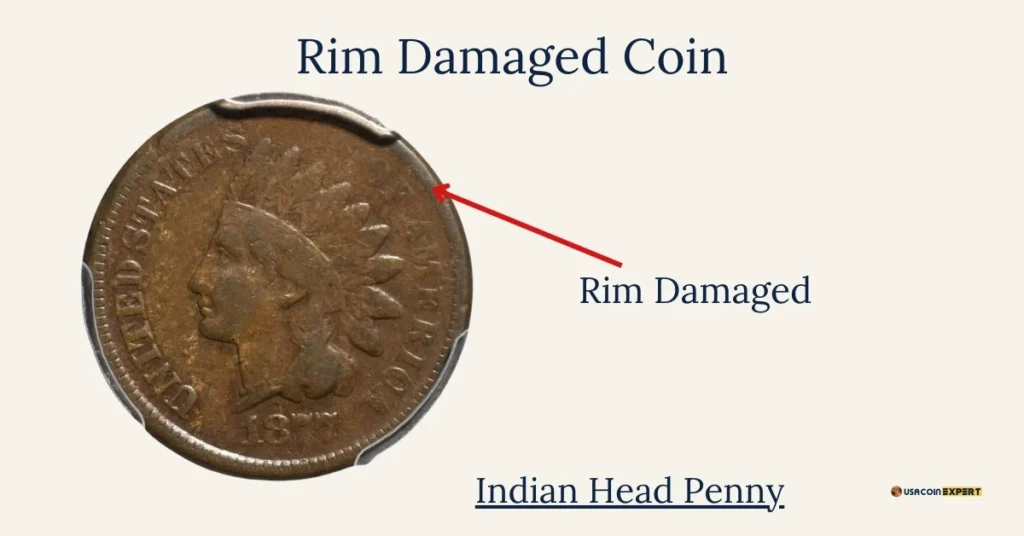
- Common Causes: Dropping coins, handling them carelessly, or striking the edges against hard surfaces can result in dents, nicks, or flattening.
- Examples: Inspect the coin’s edge for irregularities like indentations or areas that appear compressed.
- Impact: Rim damage disrupts a coin’s symmetry and reduces its aesthetic appeal, lowering its grade.
4. Environmental Damage
- Spotting the Signs: Look for corrosion, discoloration, or pitting on the coin’s surface. These are often caused by exposure to moisture, chemicals, or extreme temperatures.
- Prevention Tips: Store coins in a cool, dry place using materials like silica gel to reduce humidity and protect against environmental factors.
- Impact: Environmental damage can result in a coin being labeled as “damaged” or “environmentally damaged,” significantly decreasing its value.
5. Wear and Loss of Detail
- How to Identify: High-relief areas, such as the coin’s central designs or inscriptions, are often the first to show wear. Use a loupe to examine these areas closely.
- Causes: Circulation and frequent handling gradually wear down a coin’s features.
- Impact: Loss of detail leads to a lower grade, moving a coin from higher uncirculated grades (like MS-60) to circulated grades (like VF-20).
6. Planchet Flaws

- What to Look For: Minting defects such as cracks, lamination errors, or voids in the metal surface.
- Differentiating Flaws: Mint errors like these can sometimes be collectible, but post-mint damage from mishandling generally lowers the grade.
- Impact: Planchet flaws typically lower a coin’s grade unless they are recognized as rare mint errors.
7. Edge and Mint Mark Issues
- Identifying Problems: Look for altered or misaligned mint marks and tampering with the coin’s edge (e.g., filing or re-engraving).
- Impact: Alterations undermine authenticity and reduce grading trustworthiness, often leading to the coin being labeled as “details” or ungradable.
8. Toning or Patina
- Natural vs. Artificial: Natural toning occurs gradually, often enhancing the coin’s appeal. Artificial toning can look unnatural with overly bright or uneven colors.
- Why It Matters: Suspicious toning raises doubts about authenticity and can lead to grading penalties or rejection.
9. Improper Storage Damage
- Common Issues: PVC residue (green slime), scratches from loose storage, or staple marks from holders can mar a coin’s surface.
- Prevention: Use archival-quality storage materials like coin capsules or acid-free flips. Avoid using plastic with PVC or stapled holders.
- Impact: Damage from improper storage lowers a coin’s visual appeal and its grade.
You can Read : Guide to Coin Storage solution for Collectors
10. Dents or Gouges
- Spotting Deep Marks: Look for areas where the surface has been deeply indented or gouged, often due to heavy impacts.
- Impact: Severe dents or gouges are immediately noticeable and can significantly downgrade a coin’s condition or even render it ungradable.
Tools and Techniques for Identifying Coin Damage
Accurately identifying coin damage requires the right tools and techniques. Whether you’re a novice collector or an experienced numismatist, using these methods can help you assess a coin’s condition effectively and avoid mistakes that may reduce its grade.
1. Use of Magnification Tools
- Essential Equipment:
- 10x Loupe: A magnifying glass that provides a closer look at fine details, such as scratches, wear, or mint marks.
- Microscope: Useful for identifying microscopic damage, planchet flaws, or die imperfections. Digital microscopes can provide high-resolution views and allow for image capture.
- How to Use:
- Hold the coin under a steady light source and position the loupe or microscope at the proper angle to examine its surface and edges.
- Focus on high-relief areas, as these are more prone to wear and damage.
2. Proper Lighting and Angles for Inspection
- Lighting Matters:
- Use natural or diffused lighting for general inspection. Avoid overly bright or direct light, which can obscure small details.
- An adjustable desk lamp with a soft white bulb works well for highlighting surface imperfections.
- Angles for Better Viewing:
- Tilt the coin under the light to detect subtle scratches, cleaning marks, or uneven toning.
- Rotate the coin to examine its rims, edges, and any raised details for nicks or flattening.
3. Cleaning Myths and How to Avoid Damaging Coins
- Common Cleaning Myths:
- Myth: Cleaning improves a coin’s value and grade.
- Fact: Cleaning often causes scratches, removes the natural patina, and leaves visible damage, which lowers the coin’s grade.
- What to Avoid:
- Do not use abrasive materials, harsh chemicals, or polishing agents. These can strip the coin’s surface and leave permanent marks.
- Never scrub a coin with a brush or cloth, even if it seems soft.
- Proper Care Tips:
- If a coin is dirty, consult a professional before attempting any cleaning. Preservation, rather than cleaning, is usually the best approach.
4. How to Interpret Professional Grading Reports
- What a Grading Report Includes:
- Grade: The numerical or descriptive grade assigned to the coin (e.g., MS-65, VF-20).
- Designation: Any special designations, such as “Full Bands” or “Prooflike,” indicating exceptional characteristics.
- Comments: Notes about visible damage, cleaning, or alterations.
- How to Use Reports:
- Match the report’s findings with your observations to understand why the coin received its grade.
- Look for terms like “Details” or “Environmental Damage,” which indicate issues that affected grading.
- Use the report to learn what to look for in future coin inspections.
Preventing Damage to Your Coins
Proper care and handling are essential for preserving your coin collection’s condition and value. By following best practices, you can minimize the risk of damage and ensure your coins remain in pristine condition for years to come.
1. Best Practices for Coin Handling
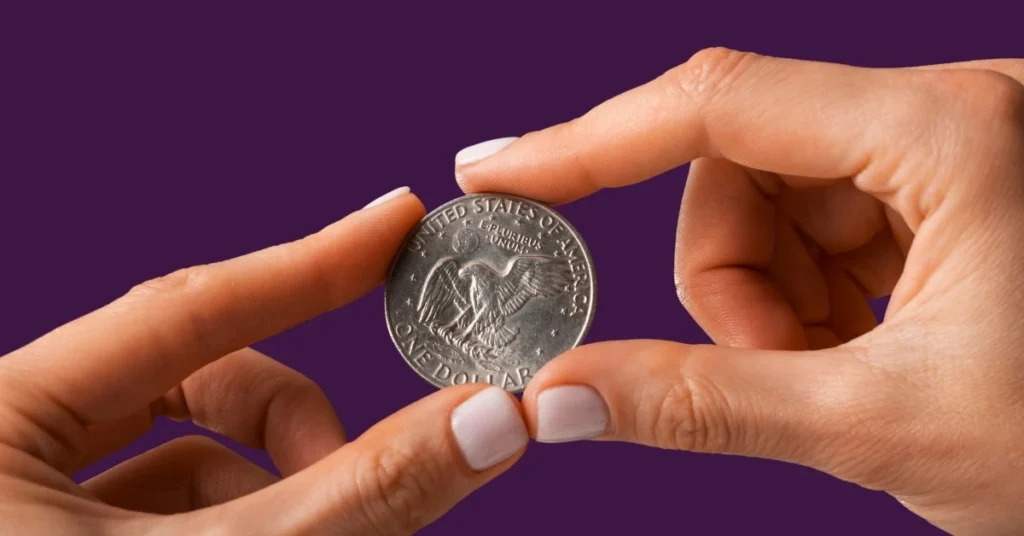
- Use Gloves:
- Always wear cotton or nitrile gloves when handling coins. Skin oils and dirt can transfer to the coin’s surface, causing discoloration or corrosion over time.
- Hold by the Edges:
- Handle coins only by their edges to avoid touching the face or reverse. This reduces the risk of leaving fingerprints, smudges, or moisture on the surface.
- Avoid Overhandling:
- Limit direct handling of coins. Whenever possible, view them in their holders or with tools like a loupe or microscope.
2. Storage Recommendations
- Archival-Quality Holders:
- Use holders made from inert materials such as Mylar or hard plastic. Avoid holders containing PVC, as this material can produce a sticky residue that damages coins.
- Capsules and Tubes:
- For valuable coins, use air-tight capsules to prevent exposure to air and moisture. Coin tubes are ideal for storing bulk collections like rolls of pennies or nickels.
- Coin Albums and Boxes:
- Store coins in albums with acid-free pages or in sturdy, well-padded boxes designed for numismatics. Ensure the coins fit snugly to prevent movement and scratches.
- Silica Gel Packs:
- Place silica gel packets in your storage containers to absorb excess moisture. This helps prevent corrosion and toning caused by humidity.
- Temperature and Humidity Control:
- Store coins in a stable environment with low humidity and consistent temperatures. Avoid storing coins in attics, basements, or areas prone to temperature fluctuations.
3. Insurance and Safe Deposit Box Tips for High-Value Coins
- Insurance Coverage:
- Insure your coin collection through specialized collectible insurance policies. Document each coin’s value with professional appraisals and grading reports.
- Safe Deposit Boxes:
- For high-value or rare coins, consider renting a safe deposit box at a bank. These boxes provide secure, climate-controlled storage and protect against theft or fire.
- Home Safes:
- If you prefer to store coins at home, invest in a high-quality, fireproof safe. Ensure the safe is placed in a secure, temperature-stable location.
- Inventory Records:
- Keep detailed records of your collection, including photos, grades, and receipts. This helps with insurance claims and tracking the value of your collection over time.
Seeking Professional Help
Professional assistance can be invaluable when assessing, grading, or appraising coins. Knowing when and how to seek expert help ensures that your collection is accurately evaluated and properly preserved.
1. When to Consult a Coin Grading Service
- Purpose of Grading Services:
- Grading services, such as the Professional Coin Grading Service (PCGS) or the Numismatic Guaranty Company (NGC), provide an unbiased evaluation of your coin’s condition, authenticity, and grade.
- When to Use Them:
- Rare Coins: When you have coins that are rare or have a high market value, professional grading can maximize their credibility and appeal to buyers.
- Authentication Needs: If you suspect a coin may be counterfeit or altered, a grading service can confirm its authenticity.
- Resale or Auction: Graded coins typically fetch higher prices because buyers trust the expert certification.
- Submission Process:
- Most grading services require you to submit coins through an authorized dealer or as a direct member. Ensure you follow their packaging and shipping instructions to prevent damage.
2. Benefits of Professional Appraisals
- Accurate Valuation:
- Appraisals provide a clear, professional assessment of your coin’s current market value, which is essential for insurance, resale, or estate planning.
- Expert Knowledge:
- Appraisers specialize in identifying rare varieties, historical significance, and market trends that might increase a coin’s value.
- Building Trust:
- An appraisal from a trusted expert adds credibility when selling coins, making transactions smoother and more profitable.
- Estate and Collection Planning:
- Appraisals can help organize and value entire collections, providing clarity for heirs or future sales.
3. Resources for Finding Reputable Coin Experts
- Reputable Grading Services:
- Look for established organizations like PCGS and NGC, known for their consistent and trusted grading standards.
- Authorized Dealers:
- Many grading services list authorized dealers who can help you submit coins or provide appraisals. These dealers are vetted for their expertise.
- Numismatic Associations:
- Organizations such as the American Numismatic Association (ANA) maintain directories of certified appraisers and dealers.
- Local Coin Shops and Clubs:
- Visit trusted coin shops or join numismatic clubs to network with experienced collectors and professionals.
- Online Reviews and Forums:
- Platforms like CoinTalk or Reddit’s r/coins can provide recommendations and reviews of experts and services.
- References and Accreditation:
- Always verify credentials, memberships, and certifications before choosing an expert. Look for affiliations with ANA or similar bodies.
FAQ: How to Spot Damage That Lowers a Coin’s Grade
1. Why does a coin’s grade matter?
A coin’s grade determines its condition, rarity, and overall value. Higher-grade coins typically command higher prices, making grading an essential aspect of coin collecting and investing.
2. Can I clean my coins to improve their grade?
No, cleaning often damages the coin’s surface, leaving scratches or removing the natural patina. This can lead to a lower grade and decreased value. It’s best to leave coins in their original condition.
3. How can I tell if a coin has been cleaned?
Cleaned coins often have an unnatural shine, visible hairlines, or uneven surfaces. Under magnification, you may see fine scratches left by abrasive cleaning methods.
4. What tools are essential for inspecting coin damage?
A 10x loupe or digital microscope, proper lighting, and archival-quality storage materials are essential for inspecting and protecting your coins.
5. What is the most common type of coin damage?
Surface scratches, wear from circulation, and improper storage (such as PVC residue) are among the most common types of damage.
6. How can I prevent environmental damage to my coins?
Store coins in a cool, dry place using archival-quality materials like airtight holders or silica gel packets. Avoid exposing coins to humidity, chemicals, or extreme temperatures.
7. Should I use gloves to handle coins?
Yes, wearing cotton or nitrile gloves prevents oils and dirt from transferring to the coin’s surface, protecting it from fingerprints and corrosion.
8. How do I know if a coin is worth grading professionally?
Consider professional grading for rare, high-value, or potentially counterfeit coins. Grading enhances a coin’s marketability and verifies its authenticity and grade.
9. What’s the difference between natural and artificial toning?
Natural toning develops over time due to exposure to air and elements, often adding aesthetic value. Artificial toning appears unnatural, with bright, uneven colors, and may reduce a coin’s grade.
10. How do I find a reputable coin grading service?
Trusted services like PCGS or NGC are industry leaders in coin grading. Check their websites for submission instructions or authorized dealers in your area.
11. Can rim damage affect a coin’s grade?
Yes, rim damage like nicks, dents, or flattening significantly impacts a coin’s symmetry and overall appeal, leading to a lower grade.
12. What’s the best way to store high-value coins?
Store high-value coins in airtight capsules or a safe deposit box. Use climate-controlled environments and consider insuring your collection.
13. How do professional grading reports help collectors?
Grading reports provide an unbiased evaluation of a coin’s grade, authenticity, and condition. They increase buyer trust and serve as a reliable reference for insurance or resale.
14. Can environmental damage be reversed?
Some environmental damage, like PVC residue, can be removed by professionals. However, most damage, such as corrosion or pitting, is permanent and affects the coin’s grade.
15. Where can I get coins appraised?
Seek appraisals from professional numismatists or certified dealers affiliated with trusted organizations like the American Numismatic Association (ANA). Verify credentials before proceeding.



